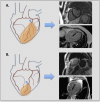Contemporary cardiovascular imaging methods for the assessment of at-risk myocardium
- PMID: 24366853
- PMCID: PMC3959708
- DOI: 10.1161/JAHA.113.000473
Contemporary cardiovascular imaging methods for the assessment of at-risk myocardium
Keywords: area at risk; diagnosis; imaging; myocardial infarction.
Figures






Similar articles
-
T2-weighted imaging to assess post-infarct myocardium at risk.JACC Cardiovasc Imaging. 2011 Sep;4(9):1014-21. doi: 10.1016/j.jcmg.2011.07.005. JACC Cardiovasc Imaging. 2011. PMID: 21920341 Free PMC article. No abstract available.
-
Electrocardiographic measures of myocardial function and necrosis.JACC Cardiovasc Imaging. 2009 Oct;2(10):1195-7. doi: 10.1016/j.jcmg.2009.08.002. JACC Cardiovasc Imaging. 2009. PMID: 19833309 No abstract available.
-
Myocardial edema imaging of the area at risk in acute myocardial infarction: seeing through water.JACC Cardiovasc Imaging. 2009 Jul;2(7):832-4. doi: 10.1016/j.jcmg.2009.04.007. JACC Cardiovasc Imaging. 2009. PMID: 19608132 No abstract available.
-
[Clinical use of cardiovascular magnetic resonance in viability assessment in patients after myocardial infarction--new method].Przegl Lek. 2004;61(6):669-73. Przegl Lek. 2004. PMID: 15724662 Review. Polish.
-
The role of cardiovascular magnetic resonance in patients with acute coronary syndromes.Prog Cardiovasc Dis. 2011 Nov-Dec;54(3):230-9. doi: 10.1016/j.pcad.2011.09.001. Prog Cardiovasc Dis. 2011. PMID: 22014490 Review.
Cited by
-
The ebb and flow of cardiac lymphatics: a tidal wave of new discoveries.Physiol Rev. 2023 Jan 1;103(1):391-432. doi: 10.1152/physrev.00052.2021. Epub 2022 Aug 11. Physiol Rev. 2023. PMID: 35953269 Free PMC article. Review.
-
Image Quality and Dose Comparison of Single-Energy CT (SECT) and Dual-Energy CT (DECT).Radiol Res Pract. 2020 Apr 20;2020:1403957. doi: 10.1155/2020/1403957. eCollection 2020. Radiol Res Pract. 2020. PMID: 32373363 Free PMC article. Review.
-
Pixel-wise statistical analysis of myocardial injury in STEMI patients with delayed enhancement MRI.Front Cardiovasc Med. 2023 Jun 16;10:1136760. doi: 10.3389/fcvm.2023.1136760. eCollection 2023. Front Cardiovasc Med. 2023. PMID: 37396590 Free PMC article.
-
Polymeric nanoparticles in the diagnosis and treatment of myocardial infarction: Challenges and future prospects.Mater Today Bio. 2022 Apr 4;14:100249. doi: 10.1016/j.mtbio.2022.100249. eCollection 2022 Mar. Mater Today Bio. 2022. PMID: 35434594 Free PMC article. Review.
References
-
- Reimer KA, Jennings RB. The “wavefront phenomenon” of myocardial ischemic cell death. II. Transmural progression of necrosis within the framework of ischemic bed size (myocardium at risk) and collateral flow. Lab Invest. 1979; 40:633-644 - PubMed
-
- Reimer KA, Lowe JE, Rasmussen MM, Jennings RB. The wavefront phenomenon of ischemic cell death. 1. Myocardial infarct size vs duration of coronary occlusion in dogs. Circulation. 1977; 56:786-794 - PubMed
-
- Kim RJ, Wu E, Rafael A, Chen EL, Parker MA, Simonetti O, Klocke FJ, Bonow RO, Judd RM. The use of contrast‐enhanced magnetic resonance imaging to identify reversible myocardial dysfunction. N Engl J Med. 2000; 343:1445-1453 - PubMed
-
- Choi KM, Kim RJ, Gubernikoff G, Vargas JD, Parker M, Judd RM. Transmural extent of acute myocardial infarction predicts long‐term improvement in contractile function. Circulation. 2001; 104:1101-1107 - PubMed
-
- Burns RJ, Gibbons RJ, Yi Q, Roberts RS, Miller TD, Schaer GL, Anderson JL, Yusuf S. The relationships of left ventricular ejection fraction, end‐systolic volume index and infarct size to six‐month mortality after hospital discharge following myocardial infarction treated by thrombolysis. J Am Coll Cardiol. 2002; 39:30-36 - PubMed
Publication types
MeSH terms
LinkOut - more resources
Full Text Sources
Other Literature Sources
Medical

